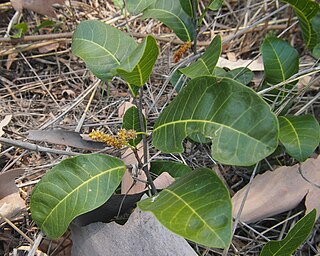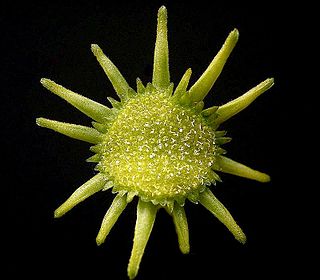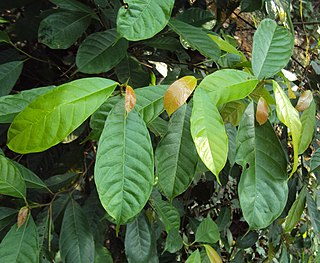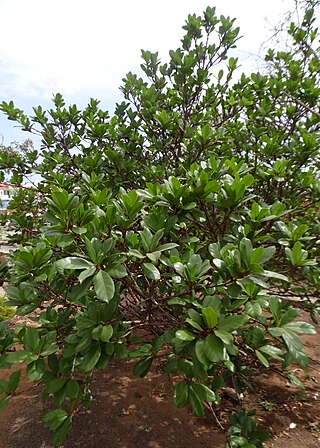
The Moraceae—often called the mulberry family or fig family—are a family of flowering plants comprising about 38 genera and over 1100 species. Most are widespread in tropical and subtropical regions, less so in temperate climates; however, their distribution is cosmopolitan overall. The only synapomorphy within the Moraceae is presence of laticifers and milky sap in all parenchymatous tissues, but generally useful field characters include two carpels sometimes with one reduced, compound inconspicuous flowers, and compound fruits. The family includes well-known plants such as the fig, banyan, breadfruit, jackfruit, mulberry, and Osage orange. The 'flowers' of Moraceae are often pseudanthia.

Maclura is a genus of flowering plants in the mulberry family, Moraceae. It includes the inedible Osage orange, which is used as mosquito repellent and grown throughout the United States as a hedging plant. It is dioecious, with male and female flowers borne on separate plants.

Trophis is a genus in the plant family Moraceae which includes five species native to the tropical Americas, ranging from Mexico through Central America and the Caribbean to Peru and northern Brazil. It is dioecious, with male and female flowers borne on separate plants.

Brosimum is a genus of plants in the family Moraceae, native to tropical regions of the Americas.

Helicostylis is a genus of flowering plants in the mulberry family, Moraceae. It includes eight species native to the tropical Americas, ranging from Costa Rica to Bolivia and southeastern Brazil.
Naucleopsis is a genus of flowering plants in the mulberry family, Moraceae. It includes 25 species native to the tropical Americas, ranging from Honduras to Bolivia and southeastern Brazil.
Perebea is a genus of flowering plants in mulberry family, Moraceae. It includes ten species native to the tropical Americas, ranging from Nicaragua to Bolivia and central Brazil.
Pseudolmedia is a flowering plant genus in the mulberry family (Moraceae). Species are found in southern Mexico, the Caribbean, and Meso- and South America. They are known in Latin America as lechechiva and used for timber, construction wood, and sometimes in folk medicine.

Sorocea is a Neotropical genus of woody plants in the family Moraceae. Its distribution ranges from Chiapas to southern Brazil. It is placed within the tribe Moreae, and is closely related to the monotypic Bagassa.

Antiaris toxicaria is a tree in the mulberry and fig family, Moraceae. It is the only species currently recognized in the genus Antiaris. The genus Antiaris was at one time considered to consist of several species, but is now regarded as just one variable species which can be further divided into five subspecies. One significant difference within the species is that the size of the fruit decreases as one travels from Africa to Polynesia. Antiaris has a remarkably wide distribution in tropical regions, occurring in Australia, tropical Asia, tropical Africa, Indonesia, the Philippines, Tonga, and various other tropical islands. Its seeds are spread by various birds and bats, and it is not clear how many of the populations are essentially invasive. The species is of interest as a source of wood, bark cloth, and pharmacological or toxic substances.

Pharmacosycea is one of six subgenera currently recognised in the genus Ficus. It was proposed by E. J. H. Corner in 1967 to unite section Pharmacosycea with Oreosycea.

Ficus americana, commonly known as the West Indian laurel fig or Jamaican cherry fig, is a tree in the family Moraceae which is native to the Caribbean, Mexico in the north, through Central and South America south to southern Brazil. It is an introduced species in Florida, USA. The species is variable; the five recognised subspecies were previously placed in a large number of other species.

Treculia is a genus of trees in the plant family Moraceae that is native to west and central Africa and Madagascar. The best-known member of the genus, Treculia africana, commonly known as the African breadfruit, is used as a food plant.

Dorstenia is a genus within the mulberry family, Moraceae. Depending on the author, there are said to be 100 to 170 species within this genus, second only in number to the genus Ficus within Moraceae. Plants of the World Online currently accepts 122 species. Dorstenia species are mainly known for their unusual inflorescences and growth habits. Dorstenia is named in honor of the German physician and botanist Theodor Dorsten (1492–1552). The type species is Dorstenia contrajerva.

Ficus nervosa is a tree in the family Moraceae which grows up to a height of 35 metres. It is native to southern China, Taiwan and tropical Asia. The tree is grown in coffee plantations for shade.
Cornelis Christiaan (Cees) Berg (1934–2012) was a Dutch botanist known for his work on the plant family Moraceae.

''Ficus cyathistipula'', the African fig tree, is a species of fig that is native to the tropical forest regions of Africa. They may be small trees, shrubs or hemi-epiphytic lianas, and are widespread in the moist tropics, where they may be found in Afromontane or rainforest, often overhanging pools. The figs are reddish when ripe, and have thick, spongy walls that enable them to float on water. They are named for their cup-shaped (cyathus-) and persistent stipules (stipula).
Prainea is a genus of trees in the plant family Moraceae. It is sometimes treated as a subgenus of Artocarpus. It includes two species native to Peninsular Thailand, Peninsular Malaysia, Sumatra, Borneo, the Maluku Islands, New Guinea, and the Solomon Islands. The species are dioecious, with male and female flowers borne on separate plants.
Maquira is a genus of trees in the family Moraceae, native to South America.
Parartocarpus is a genus of trees in the family Moraceae. It is dioecious, with male and female flowers borne on separate plants.












